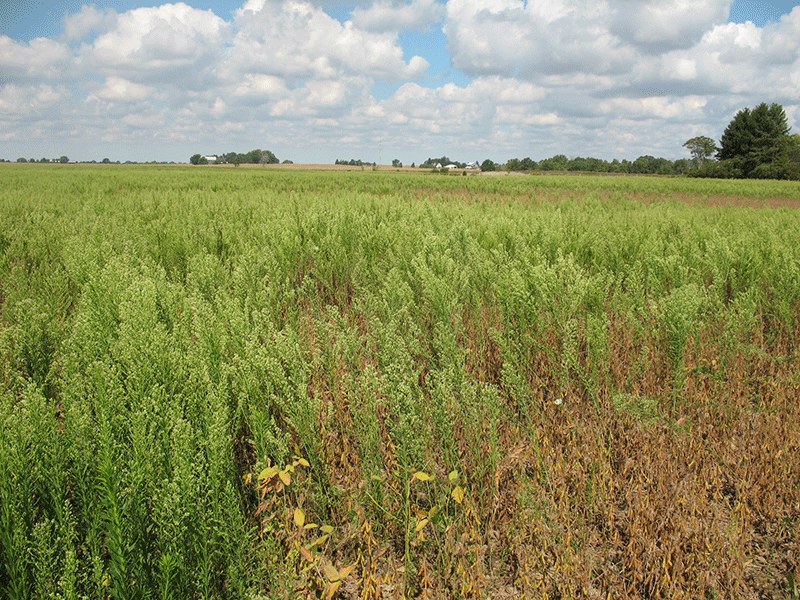A plan for resistant fleabane
CANADA FLEABANE REQUIRES MULTI-YEAR MANAGEMENT
GLYPHOSATE-RESISTANT Canada fleabane first appeared in Ontario in Essex County in 2010. At that time only a few fields were affected. Over a five-year period, however, the number of affected counties has risen to 28. Glyphosate-resistant Canada fleabane is now found from Essex County in the southwest, all the way to Glengarry County on the Quebec border.
PHOTO: CORN AND WINTER WHEAT PROVIDE DECENT OPTIONS FOR CONTROL OF GLYPHOSTATE-RESISTANT FLEABANE. IT’S A SERIOUS PROBLEM IN SOYBEANS, HOWEVER.

In just five years it has spread a staggering 800 kilometres. Worst of all, the problem isn’t showing any signs of slowing; in fact, it’s increasing at an alarming rate. On top of that, some 11 counties not only have glyphosate-resistant Canada fleabane, but multiple-resistant Canada fleabane.
This presents a huge challenge for Ontario farmers. But, according to Dr. Peter Sikkema, professor of field crop management at the University of Guelph-Ridgetown Campus, the problem is manageable.
Managing glyphosate-resistant Canada fleabane requires a multi-year plan. Sikkema says it can be managed quite effectively using a corn-soybean-wheat rotation. “I never thought I would say that five years ago,” he says, “but I think our research has brought us that far forward that we do have effective options for Ontario farmers”.
Sikkema and his team have been evaluating multiple herbicide options in a corn, soybean, and wheat rotation since 2011. The results have been interesting.
CONTROL IN CORN
In Sikkema’s trials, the best pre-plant options in corn were as follows: Banvel (90 per cent control), Callisto plus atrazine (91 per cent control), Integrity (92 per cent control), and Marksman (95 per cent control). These herbicides were applied to emerged fleabane, but prior to seeding corn.
Even if there are escapes in corn fields, Sikkema says farmers still have options. There are, in fact, four post-emergence corn herbicide options that provide good control: Pardner plus atrazine (91 per cent control), Distinct (91 per cent control), Banvel (96 per cent control), and Marksman (96 per cent control).
“I think, based on our research, that glyphosate-resistant Canada fleabane can be managed quite effectively in corn,” says Sikkema.
CONTROL IN WHEAT
Glyphosate-resistant Canada fleabane can be controlled in winter wheat, as well, however what works on this weed can be tough on the crop. Sikkema says that dicamba-based herbicides — including Banvel, Dyvel and Target — provided good control, however, he would never recommend those herbicides because they are too injurious to winter wheat.
According to Sikkema, the best option is Infinity, which provided 92 per cent control in his trials. “The downside of using Infinity for the control of glyphosate-resistant Canada fleabane is that it will also injure red clover if it’s under-seeded to winter wheat,” he says. “So that’s a real disadvantage for the farmers.”
CONTROL IN SOYBEAN
Control of glyphosate-resistant Canada fleabane in soybean is much more difficult. Sikkema looked at 29 different tank mixes, representing every broadleaf herbicide registered in soybean in Ontario. None of them consistently provided commercially acceptable control of glyphosate-resistant Canada fleabane, he says.
Based on his initial research, Roundup plus Eragon provided about 80 per cent control of glyphosate-resistant control of Canada fleabane. “However, the control was extremely variable,” says Sikkema. “In 56 per cent of our trials, it provided greater than 90 per cent control, so you’d be really happy if it worked. But that means that 44 per cent of the time it provided less than 90 per cent control.”
As a result, Sikkema started looking at three-way tank mixes to provide effective control. “We looked at tank mixes of Roundup plus Eragon, and we added either 2,4-D, Gramoxone, or Sencor to that tank mix,” he says. “All three of those three-way tank mixes provided greater than 90 per cent control. The one that I think is the best is Roundup plus Eragon plus Sencor. In our trials, it provided 97 per cent control.”
“FirstRate was the best herbicide for the control of glyphosate-resistant Canada fleabane post-emergent in soybean,” he says. “However, if a farmer has multiple-resistant Canada fleabane, FirstRate’s not going to work at all.”
“This problem has just become more difficult,” he says.
With that said, it isn’t all doom and gloom. “I think our research — as well as practices by Ontario farmers — demonstrate that this weed can be managed,” he says. “It will take a lot of effort on the part of Ontario farmers and it’s going to cost them considerably more in terms of these three-way tank mixes for their burn down; but I think it’s a manageable problem. I also think that it’s going to cost farmers a lot of money in terms of increased herbicide cost, as well as yield loss due to Canada fleabane interference.”
SOLID AGRONOMIC PRACTICES
While glyphosate-resistant Canada fleabane is manageable, it requires a diversified integrated weed management plan, says Sikkema. He says growers should have a diverse rotation plan. They should also reduce their reliance on Roundup alone for weed management and use multiple herbicide modes of action on every acre, every year. If there’s an opportunity, they should use some of the newer technology as it becomes available. Where appropriate, they should use cover crops and incorporate tillage at strategic points in their long-term, diversified crop rotation, he says.
Quick action is also important, says Melody Robinson, a field agronomist with Clark Agri Service Inc. “The biggest impact we’ve seen is from rotation,” she says. “(Farmers) that identified that fleabane early on, they went immediately into corn, used something like Integrity and Callisto, and got a handle on it in that first year.”
“They were also careful about their rotations,” she says. “Either trying to stay out of soybeans for a couple of years or going into wheat or corn.”
Quick action isn’t always second nature, though, says Dale Cowan, senior agronomist at AGRIS Cooperative. The biggest challenge, he says, is with farmers who have not yet experienced heavy weed pressure.
“In the first year they have a few escapes using glyphosate and they convince themselves that they can live with it,” he says. “However, (fleabane) is a prolific seed producer with upwards of 250,000 seeds per plant. It’s the second year that the weed is huge problem.”
Controlling fleabane is a numbers game, he says. The more seeds produced, the greater the selection pressure on the remaining chemistry.
Sikkema agrees. “I think, at the end of the day, that we need to pursue near-perfect weed control so that we reduce the weed seed return to the soil and hopefully reduce the densities that we’re dealing with in the future.” •








